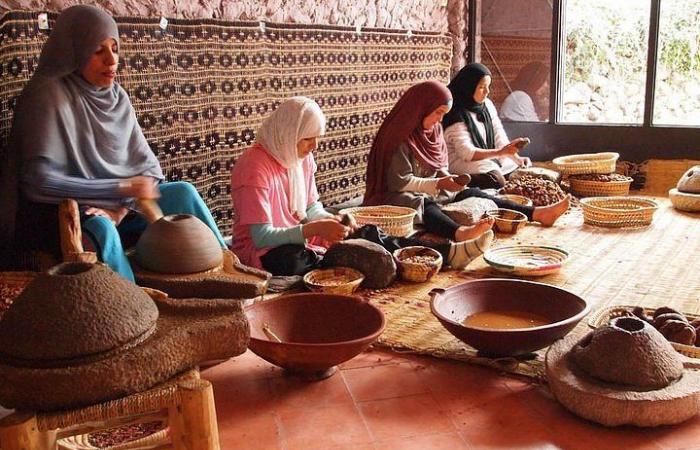Both abroad and in Morocco, the reputation of the oil is closely associated with the romantic image of cooperatives, where women sit on mats and grind argan kernels by hand using stone mills. Far from these clichés, today it is a French multinational, Olvea, which holds nearly 70% of the market, while the 621 cooperatives in the sector are inexorably emptying, according to Reporterre, an independent media which publishes surveys and reports on the ‘ecology.
A traditional product in Morocco, discovered in France and the rest of the world during the 1990s for its curative and cosmetic virtues, argan oil has since brought good fortune to European and American cosmetic brands. Benefiting from the “fair” image of Moroccan women’s cooperatives, argan oil has quite simply become a profitable business in Morocco, underlines the independent media Reporterre, alerting that its production is now swallowed up by Olvea, a French industrialist. which holds nearly 70% of the market, while the 621 cooperatives in the sector are inexorably emptying out.
Between 2008 and 2013, the market shares of the cooperative sector and the private sector were reversed, according to Lucie Polline, author of a professional mission thesis, at SupAgro Montpellier, in 2018, listed by Reporterre. “Oil production cooperatives maintained their oil volume of around 240 tonnes, which represented 80% of exports in 2008, but only 18% in 2018 [les dernières données disponibles]. The private sector has become dominant, mainly with the arrival of an international player, concomitant with the increase in volumes,” she explains. This dominant player is Olvea, specifies the media.
Read also | Why Somagec is interested in the management of the new Casablanca shipyard
The growing market share of manufacturers, including the French group, has long posed few difficulties in a growing market, but, in 2015, the curve began to bend.
Since then, exports have plateaued: 1,202 tonnes were exported in 2021, according to the National Agency for the Development of Oasis Zones and the Argan Tree, compared to 1,348 tonnes in 2019. Since then, export volumes have stabilized: 1,202 tonnes were exported in 2021, compared to 1,348 tonnes in 2019, according to the National Agency for the Development of Oasis Zones and the Argan Tree. . Have they reached the limits of the forest, nearly 800,000 hectares between Essaouira and Agadir, on the Atlantic coast of Morocco?, wonders the author of the report in the Agadir region. According to the latter, overgrazing and intensive cultivation in the middle of the argan grove reduce its capacities a little more every day. And the increased drought that accompanies global warming gives trees no respite. It also deprives the herds of camels which usually travel further south from grazing. Their shepherds then guide them towards the argan grove, where they cause terrible damage by tearing off the branches with their powerful jaws.
The heat also favored intensive cultivation of fruits and vegetables. The immense greenhouses and fenced fields pierce the argan grove on all sides in the Agadir region and lower the level of the water tables, pushing the argan trees to fetch water ever deeper, he notes, adding that in This landscape, the different argan oil producers compete for a structurally limited and increasingly rare resource: the fruits of the argan tree.
Read also | Moroccan venture capitalist EmergingTech Ventures set to raise $40 million to support startups
According to Reporterre, dozens of women’s argan cooperatives have therefore closed, the others survive in the hope of better days. Others have become subcontractors. This is the case in the region of Sidi Ifni and Guelmim, south of Agadir where cooperatives dedicated solely to crushing have been created in number recently, proof that the activity continues, but that it has passed a little more in the hands of large industrialists, underlines the media. The latter have long subcontracted the crushing of argan nuts, the only stage of production to still escape mechanization. Some cooperatives accept 30 DH to crush a kilo of argan fruit when isolated women receive between 10 and 30 DH for the same work, or half a day of gestures as beautiful as they are repetitive. Except that, “today, all the cooperatives have contracts with Les Domaines, Top Agri, Olvea, etc.,” says Rachida, president of another cooperative in the Ameskroud region. We have become service cooperatives. They take the fruit to us and we only do the crushing for Olvea. » Who is this French multinational?
Founded in 1929, in Fécamp (Seine-Maritime), Olvea first developed thanks to cod fishing off the coast of Newfoundland and Greenland, by making fish oil, according to Reporterre. In 2005, it opened a first subsidiary in Agadir, whose waters are rich in sardines. Two years later, following the arrival in the family group of Caroline Mayaud-Daudruy, great-granddaughter of the founder, an argan oil extraction unit, Marogania, was built on the site. from the Agadir factory. The whole is today called Olvea Morocco.






